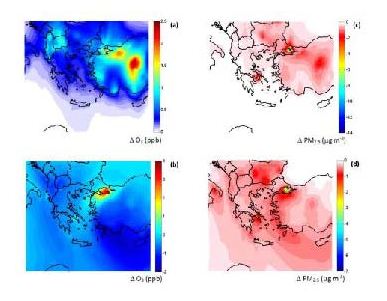Also discussed here: Impacts of East Mediterranean megacity emissions on air quality( 21 page pdf, U. Im and M. Kanakidou, Atmos. Phy. July 23, 2012)
And here: Mediterranean capital pollution has far-reaching effects on air quality(Science for Environment Policy, Nov. 22, 2012)
Today we review research that examines the state of air pollution in several eastern Mediterranean magacities (Cairo, Istanbul, Athens - over 10M population) and the impact of some mitigation strategies on the cities as well as on the surrounding region. What is special about these urban areas is the combination of a large number of vehicles which often lack catalytic coverts or particulate filters and the year round impact of very warm temperatures which exacerbate the air pollution, especially ozone.

Key Quotes:
“Large urban agglomerations with more than 10 million inhabitants are characterized as megacities and represent concentrated sources of anthropogenic emissions”
“The Eastern basin of the Mediterranean and the surrounding regions, include two megacities: the Greater Cairo area (GCA) (>15 million, Egypt) at the south edge of the basin and the Greater Istanbul Area (GIA) (>12 million inhabitants, Turkey) at the North East edge, as well as several large urban centers like to its northern part the Greater Athens area (GAA) (>4 million) in Greece”
“[Athens] The massive number of registered vehicles in circulation, growing at a rate of 7% yearly, is allegedly the major cause of air pollution related problems in the area, taking into account the large proportion of non-catalytic (0.8 million) or powered by old technology diesel engines vehicles (0.2 million)… observations from the Greek Ministry of Environment air pollution network in Athens since 1987, show a significant downward trend for almost all primary pollutants in all stations.”
“[Cairo] GCA accommodates 50% of Egypt’s road transport fleet, 60% of which is over 10 years old, lacking modern emission cutting features like catalytic converters.. Open fire burnings is a common practice and a major contributor to air pollution in Egypt.. Year-long, mean levels often exceed the Egyptian and European Union air quality standards of 60 ppbv for daytime (8-h) O3 mixing ratios….the area is characterized by elevated levels of surface PM, with annual averages around 100 μg m-3 and above”
"[Istanbul] Between 1980 and 1990 the consumption ratio of coal to fuel-oil increased from 0.68 (in 1980) to 3.09 (in 1990).. The highest ozone levels were observed during sunny and warm summer days (maximum temperatures >25 °C) with southwesterly surface winds…GIA experiences high and variable levels of PM10 and PM2.5 particles (Table 3). Ozdemir et al. (2009) reported average PM10 levels of about 66 μg.m-3 observed at 10 Istanbul municipality stations during the last 10 years with values ranging from 47 μg.m-3 to 115 μg.m-3.”
"[eastern Mediterranean] Ground- based observations over the area show high concentrations of aerosols, in both PM10 and PM2.5 fractions .., with PM2.5/PM10 ratios around 0.5.., in agreement with the satellite observations”
“Impacts of regional anthropogenic emissions on the domain-mean surface pollutant levels (up to 17%for summertime O3 and 52%for wintertime PM2.5) are much higher than those from GIA and GAA anthropogenic emissions together (_1% for O3 and _6% for PM2.5, respectively).”
“the impact of long range transport is significant in the region, even higher than the contributions of the local anthropogenic emissions and therefore, should be considered when quantifying and evaluating the impacts of emissions and mitigation”






No comments:
Post a Comment